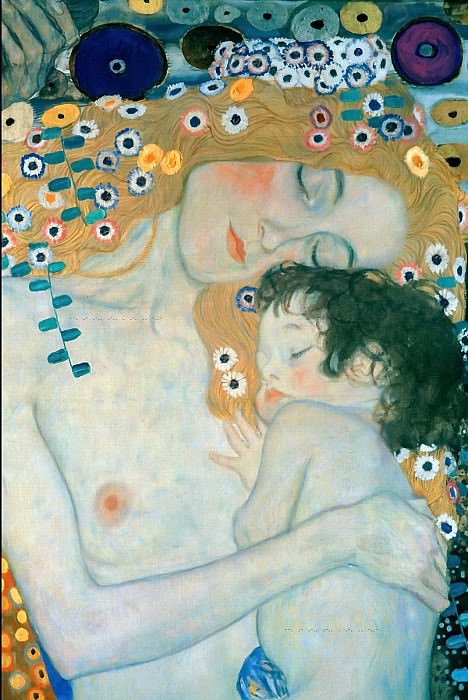The Three Ages of Woman (fragment) Gustav Klimt (1862-1918)
Gustav Klimt – The Three Ages of Woman (fragment)
Edit attribution
Download full size: 1068×1600 px (0,5 Mb)
Painter: Gustav Klimt
Location: National Gallery of Modern Art, Rome (Galleria Nazionale d’Arte Moderna).
Gustav Klimt repeatedly addressed the subject of women. He was concerned with the inner world of women, as can be seen in the predecessor of the painting The Three Ages of Woman, the painting Love. In his unusual painting, the artist tried to address the broadest possible subject - the psychological state of women in different age categories. Klimt conventionally divided the whole life of a woman into three periods: youth, maturity and old age.
Description of Gustav Klimt’s painting The Three Ages of a Woman
Gustav Klimt repeatedly addressed the subject of women. He was concerned with the inner world of women, as can be seen in the predecessor of the painting The Three Ages of Woman, the painting Love. In his unusual painting, the artist tried to address the broadest possible subject - the psychological state of women in different age categories.
Klimt conventionally divided the whole life of a woman into three periods: youth, maturity and old age. The artist was able to combine the seemingly impossible - life and death, drawing between them a thin connecting thread. Therefore, the picture evoked a variety of feelings in the audience - joy, regret, sadness and joy.
The childish figure symbolizes the carefree period in the girl’s life, when she is bathed in affection and has not yet tasted the grief of a woman’s fate. The stylized image of the adult woman draws attention to her mature beauty and maternal instincts - she cradles the child (that is, herself) to her breast with care. Next to her is an elderly, hunched over woman, the veins in her arms showing that she has worked many hard days in her life.
A certain symbolism is observed in the juxtaposition of the two images - the young woman who is enjoying her life is depicted with her head held high. The old woman, on the contrary - with her head down, symbolizing humility and understanding of her fate.
Society accepted the painting in different ways: some spoke out against the erotic content of the picture (there are few of them), and some pointed out its absence, because the intimate areas are covered by naked bodies and an unusual fabric, similar to the universe. If you look closely at the painting, there is no eroticism there; it radiates energy and light on the one hand, and deadly breath on the other. In a word, everyone understands the painting differently, in principle, like all of Klimt’s works.
Кому понравилось
Пожалуйста, подождите
На эту операцию может потребоваться несколько секунд.
Информация появится в новом окне,
если открытие новых окон не запрещено в настройках вашего браузера.
You need to login
Для работы с коллекциями – пожалуйста, войдите в аккаунт (open in new window).




















You cannot comment Why?
The painting The Three Ages of Woman (fragment) by Gustav Klimt depicts a tender and intimate moment between a mother and her child.
Description:In the foreground, a woman with long, flowing golden hair, adorned with colorful flowers, embraces a sleeping infant. The womans eyes are closed, and her head is gently tilted, conveying a sense of peace and contentment. Her lips are slightly parted, and a faint blush graces her cheeks. The infant, with dark curly hair, is nestled securely in the womans arms, their faces close together, both appearing to be in a deep slumber. The bodies are rendered with soft, luminous skin tones, contrasting with the richly patterned and decorative elements that surround them. These elements include a border of stylized flowers in the womans hair and a mosaic-like background suggestive of a patterned fabric or a natural landscape. The overall impression is one of warmth, security, and maternal love.
Subtexts:The painting, despite being a fragment, evokes several layers of meaning:
In essence, the fragment of The Three Ages of Woman is a powerful evocation of love, innocence, and the fundamental human connection, rendered with Klimts distinctive opulent and symbolic style.